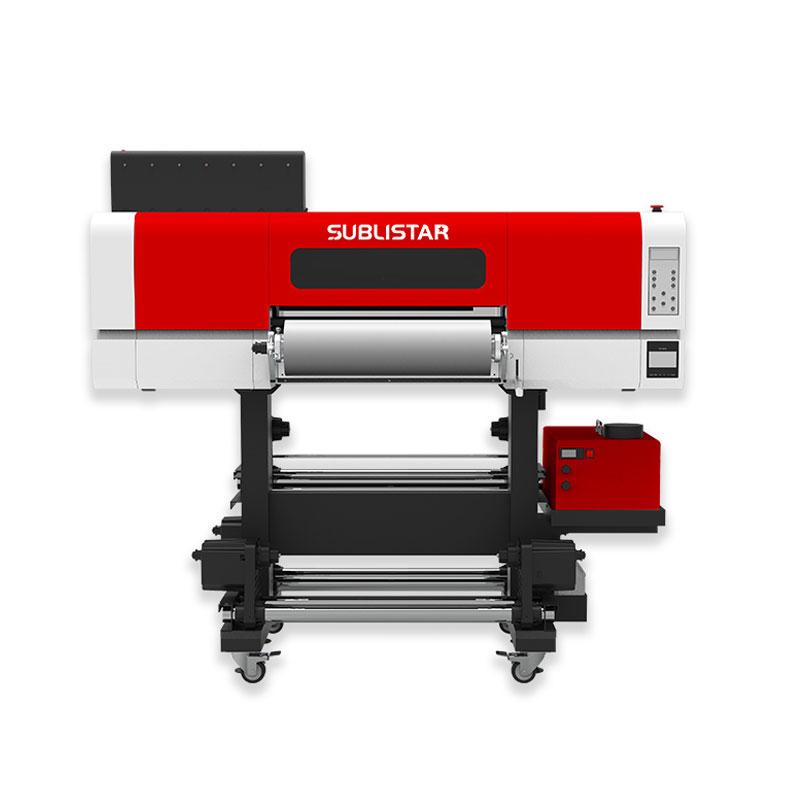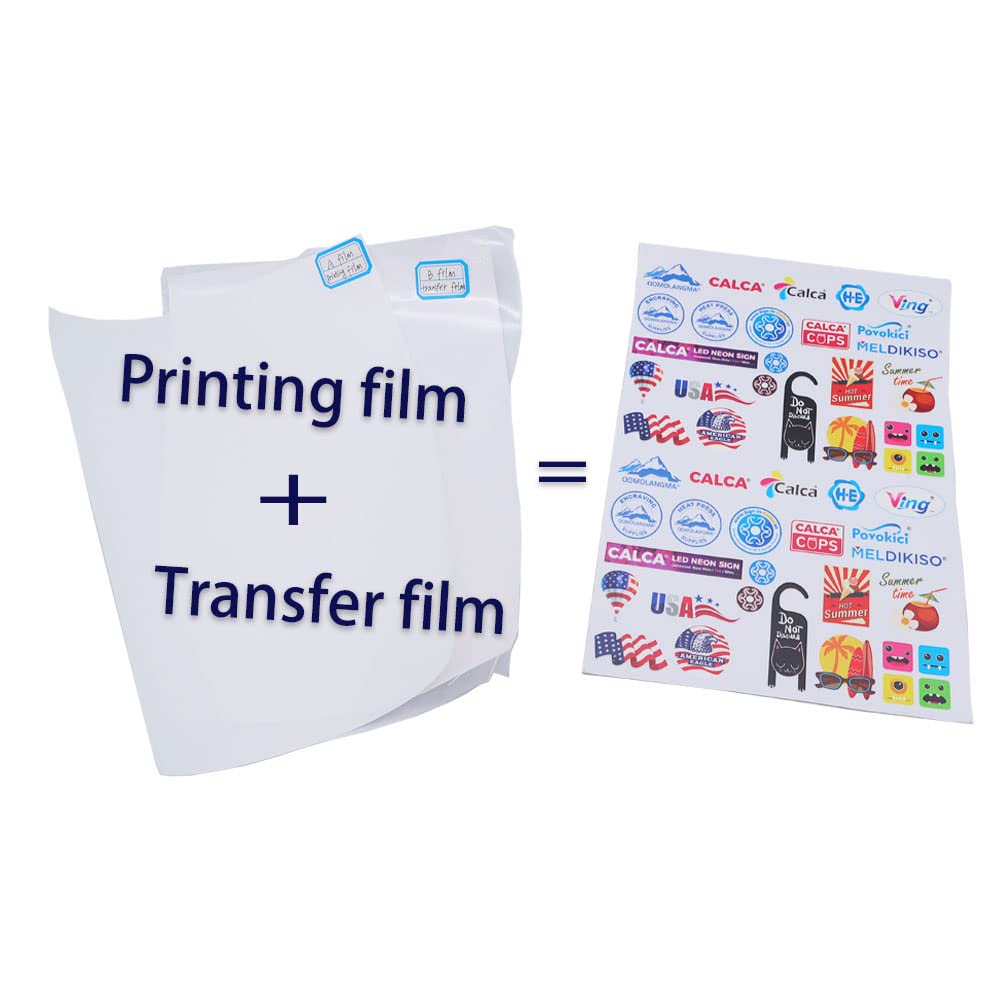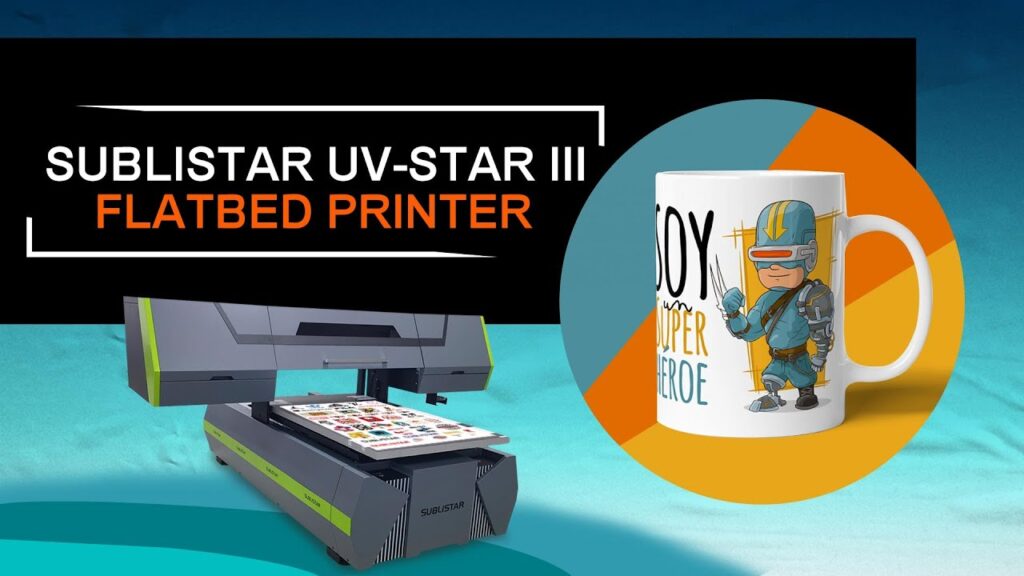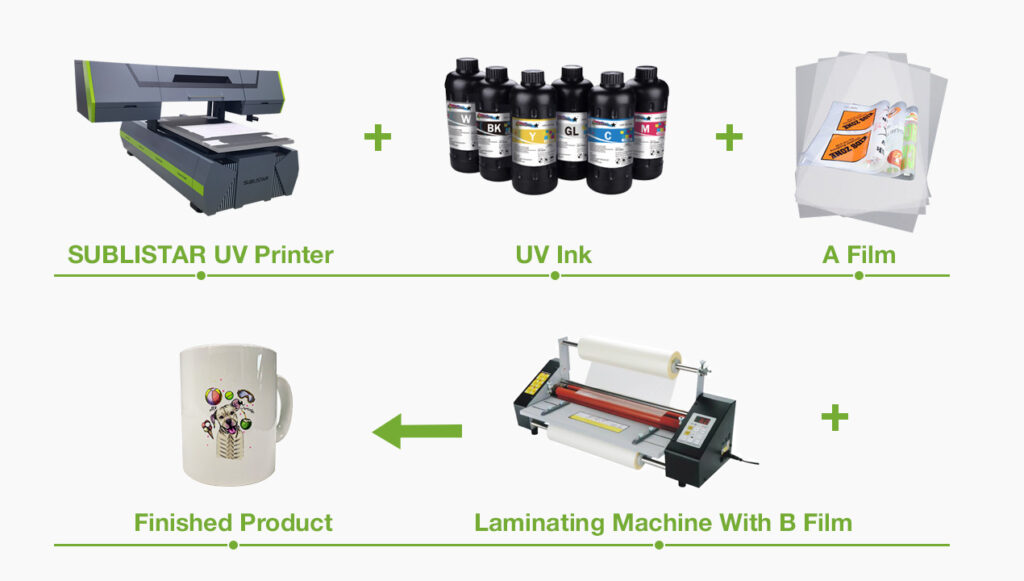
The UV DTF AB Film Printer is a digital printer that uses ultraviolet (UV) light to cure and harden special UV-sensitive inks onto a variety of materials, including plastic films and sheets.
DTF stands for “direct to film,” meaning that the printer can print directly onto the film without any intermediate transfer media.
AB film refers to the consumables needed in UV DTF printer.
UV DTF printer prints a design onto a PET film (named A Film) using UV ink and UV light.
Then, using a laminator, prints the design of A Film onto a second PET film (B Film).
After that, simply press the laminated PET film against the object with your fingertips for a second, then pull off the film like you would pull a sticker.
There is no need for heat pressing.
This way, UV DTF printing works on almost all surfaces and can print out vibrant and high-quality images accurately.

Process of Printing with UV DTF AB film Printer
In a UV DTF AB film printer, the ink is first printed by the print head onto the surface of the film.
The ink is then cured or hardened by exposure to ultraviolet light, which is emitted by a UV lamp.
The curing process converts the liquid ink into a solid state, creating a durable and long-lasting print.
One of the main advantages of the UV DTF AB film printer is its ability to print on a variety of hard material surfaces.
So print is done over AB film,then film is cut out after printing and affix to glasses, metal bowls, cell phone cards, acrylic sheets, wood calendars, including polycarbonate, polyethylene, polypropylene and PVC.
This makes it a versatile printing solution for a variety of applications, including packaging , labels, signage, awards and display graphics.

The UV DTF AB film printer also offers high-quality printing, capable of producing high-resolution graphics and text, as well as fine detail and sharp edges.
The printer is equipped with advanced printing software that allows for precise color control, ensuring consistent and accurate final prints.
Main Applications of UV DTF printers and Principle of Work
Another benefit of the UV DTF AB film flatbed printer is that it can have two application options.
The first is to print directly on hard material surfaces.
This printing method is the same as traditional UV printing – UV DTF printing, as it is called today, is printed on A film and B film is applied to A film with a laminator.
Finally, the film is cut and uncovered.
This function satisfies the need for specialty customization or batch production, such as packaging and labels,but when printing labels, an additional auxiliary machine-a laminator is needed so this require manual assistance.
Dual print heads also allow for more efficient and faster printing.
UV DTF roll-to-roll, on the other hand, requires no extra manual assistance, and after printing on A film, there is a self-contained laminator at the output end that automatically laminates with a single click.
The UV DTF printer is also designed for ease of use, with a user-friendly interface for quick and easy operation.
The printer is equipped with a built-in computer and touch-screen display that provides access to a variety of printing options and settings.
The printer can also be connected to an external computer for more advanced printing options and features.
The printing process is also simple, starting with a design on the computer side.
The printer starts printing on the platform, and after the design is printed, it gets laminated on the laminator.
In the case of UV roll-to-roll printers, the printed A-roll film is placed inside the roll, and after printing, the front-end laminator automatically laminates the film.
The last two printing methods are using manual or machine cutting, after cutting you can paste it on some hard material surface.

Maintenance of UV DTF AB film printers
In terms of maintenance, UV DTF AB film printers are relatively low maintenance and require only minimal cleaning and maintenance to keep them in good working condition.
The UV lamp used to cure the ink is the main component that may need to be replaced over time, but this is a simple process that can be done by the operator.
However, less routine maintenance does not mean that the UV DTF printhead is still a critical part of the printing process.
Sometimes it is necessary to align the print pitch to avoid cutting the printhead during printing, which not only damages the printhead but also makes the print pattern misaligned or even scratched.
In the daily printing process, UV DTF will generate a lot of heat.
Some UV printers are air-cooled, and some are water-cooled.
When using air-cooled UV printers, attention should be paid to the material in the print.
If the material is subject to deformation at high temperatures, deformation in the form of bending of the material may occur.
In this case, it is recommended to print on materials such as metal, glass and other types that are not easily deformed at high temperatures.

With UV printers that have water cooling, the costs will be higher, we have faster heat dissipation, but regular replacement of coolant and antifreeze is required.
As long as you strictly follow the machine manual and technical operating instructions, and routine maintenance, the operation of the machine will be quite stable.
In conclusion, the UV DTF AB film printer is a versatile, high quality and efficient printing solution for a wide range of applications.
Its ability to print directly on the film, producing high-resolution graphics makes it a valuable tool for a variety of industries.
The user-friendly interface and low maintenance requirements also make it an attractive option for companies looking to streamline their printing processes.
